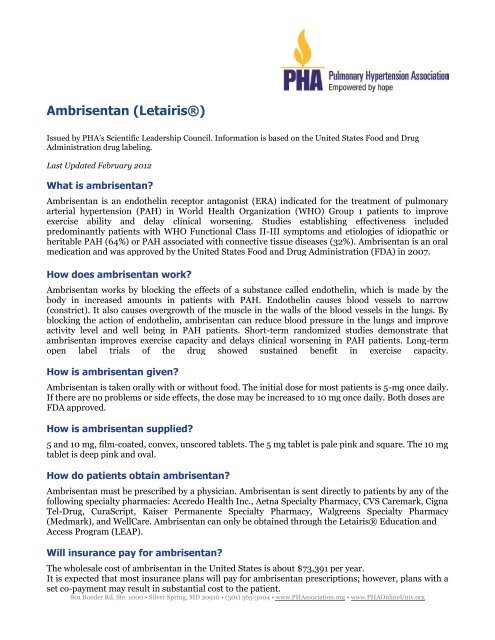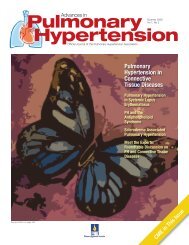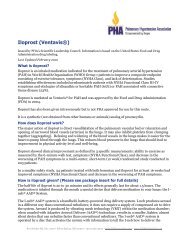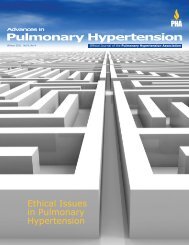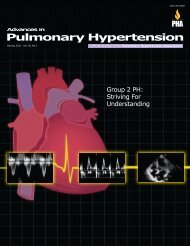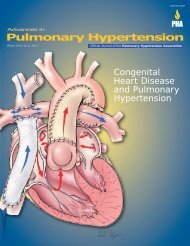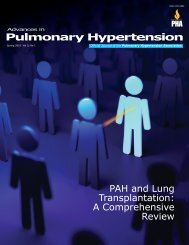Ambrisentan (Letairis®) - PHA Online University
Ambrisentan (Letairis®) - PHA Online University
Ambrisentan (Letairis®) - PHA Online University
Create successful ePaper yourself
Turn your PDF publications into a flip-book with our unique Google optimized e-Paper software.
<strong>Ambrisentan</strong> (<strong>Letairis®</strong>)<br />
Issued by <strong>PHA</strong>’s Scientific Leadership Council. Information is based on the United States Food and Drug<br />
Administration drug labeling.<br />
Last Updated February 2012<br />
What is ambrisentan<br />
<strong>Ambrisentan</strong> is an endothelin receptor antagonist (ERA) indicated for the treatment of pulmonary<br />
arterial hypertension (PAH) in World Health Organization (WHO) Group 1 patients to improve<br />
exercise ability and delay clinical worsening. Studies establishing effectiveness included<br />
predominantly patients with WHO Functional Class II-III symptoms and etiologies of idiopathic or<br />
heritable PAH (64%) or PAH associated with connective tissue diseases (32%). <strong>Ambrisentan</strong> is an oral<br />
medication and was approved by the United States Food and Drug Administration (FDA) in 2007.<br />
How does ambrisentan work<br />
<strong>Ambrisentan</strong> works by blocking the effects of a substance called endothelin, which is made by the<br />
body in increased amounts in patients with PAH. Endothelin causes blood vessels to narrow<br />
(constrict). It also causes overgrowth of the muscle in the walls of the blood vessels in the lungs. By<br />
blocking the action of endothelin, ambrisentan can reduce blood pressure in the lungs and improve<br />
activity level and well being in PAH patients. Short-term randomized studies demonstrate that<br />
ambrisentan improves exercise capacity and delays clinical worsening in PAH patients. Long-term<br />
open label trials of the drug showed sustained benefit in exercise capacity.<br />
How is ambrisentan given<br />
<strong>Ambrisentan</strong> is taken orally with or without food. The initial dose for most patients is 5-mg once daily.<br />
If there are no problems or side effects, the dose may be increased to 10 mg once daily. Both doses are<br />
FDA approved.<br />
How is ambrisentan supplied<br />
5 and 10 mg, film-coated, convex, unscored tablets. The 5 mg tablet is pale pink and square. The 10 mg<br />
tablet is deep pink and oval.<br />
How do patients obtain ambrisentan<br />
<strong>Ambrisentan</strong> must be prescribed by a physician. <strong>Ambrisentan</strong> is sent directly to patients by any of the<br />
following specialty pharmacies: Accredo Health Inc., Aetna Specialty Pharmacy, CVS Caremark, Cigna<br />
Tel-Drug, CuraScript, Kaiser Permanente Specialty Pharmacy, Walgreens Specialty Pharmacy<br />
(Medmark), and WellCare. <strong>Ambrisentan</strong> can only be obtained through the <strong>Letairis®</strong> Education and<br />
Access Program (LEAP).<br />
Will insurance pay for ambrisentan<br />
The wholesale cost of ambrisentan in the United States is about $73,391 per year.<br />
It is expected that most insurance plans will pay for ambrisentan prescriptions; however, plans with a<br />
set co-payment may result in substantial cost to the patient.<br />
801 Roeder Rd, Ste. 1000 • Silver Spring, MD 20910 • (301) 565-3004 • www.<strong>PHA</strong>ssociation.org • www.<strong>PHA</strong><strong>Online</strong>Univ.org
Medicaid and most state-run insurance plans will pay for ambrisentan. Medicare will also cover<br />
ambrisentan in most cases under the part D component of that program.<br />
Gilead Solutions (866-664-5327) offers a variety of options to cover either partial or full drug costs<br />
for any patient with qualifying financial circumstances. Caring Voice Coalition (888-267-1440), an<br />
organization that provides grants to assist with drug cost for patients with chronic illnesses, may also<br />
provide coverage if the patient qualifies for such assistance.<br />
What are the frequent side effects of ambrisentan<br />
<strong>Ambrisentan</strong> is generally well tolerated. The most frequent side effects of ambrisentan are fluid<br />
retention (ranging from swelling of the extremities to heart failure), nasal congestion, sinusitis,<br />
flushing, palpitations, nasopharyngitis, abdominal pain and constipation.<br />
Fluid retention is a known side effect of ERAs. In the clinical studies of ambrisentan, there was an<br />
increased prevalence of peripheral edema (swelling) with doses of 5 or 10 mg. The swelling was<br />
generally mild or moderate in severity and occurred with greater frequency and severity in the elderly.<br />
It is important to notify your doctor if you experience swelling. Treatment may be required including<br />
sodium and fluid restriction as well as a diuretic.<br />
The red blood cell count or hemoglobin (hematocrit) may decrease in some patients but is rarely<br />
severe enough to require transfusion.<br />
The development of abnormal liver function tests (LFTs), measured in blood samples to greater than<br />
three times the upper limit of normal may occur in patients taking ERAs but appears to be less<br />
common with ambrisentan compared to bosentan.<br />
Decreases in sperm count have been observed in men taking bosentan, another type of ERA. Based on<br />
this information and preclinical data from animal studies, it cannot be excluded that ERA’s such as<br />
ambrisentan have an adverse effect on spermatogenesis.<br />
How are side effects of ambrisentan monitored<br />
Because of the potential harm to the fetus, women of childbearing potential must have a pregnancy<br />
test before initiating therapy and subsequently on a monthly basis as long as a patient is receiving<br />
ambrisentan.<br />
Hemoglobin (red blood cell count) should be assessed prior to initiating therapy and after 1 month<br />
then monitored periodically as long as a patient is receiving ambrisentan.<br />
The FDA recently removed the black box warning related to liver injury for ambrisentan because of a<br />
low observed incidence of liver toxicity. Although monthly LFT monitoring is no longer mandatory for<br />
ambrisentan treatment, it is prudent to test liver function at the outset of all treatments for PAH and,<br />
at the prescriber's discretion, at periodic intervals thereafter.<br />
<strong>Ambrisentan</strong> should be discontinued if the liver enzymes (hepatic aminotransferases) rise to more<br />
than 5 times the upper limit of normal or if elevations are accompanied by an increased total bilirubin<br />
to more than 2 times the upper limit of normal or by signs and symptoms of liver dysfunction and<br />
other causes are excluded.<br />
What are considerations for use of ambrisentan in special populations<br />
Use of ambrisentan is contraindicated in pregnancy. <strong>Ambrisentan</strong> has been shown to be harmful to<br />
the growing fetus in rats and rabbits. Patients should not become pregnant while taking ambrisentan;<br />
therefore, two forms of contraception are recommended in order to be sure to prevent pregnancy. An<br />
exception to this recommendation would be for patients who have had a surgical sterilization<br />
procedure such as a tubal ligation or for women who use a Copper T380A or LNg 20 intrauterine<br />
device (IUD) as a form of contraception. In addition, a pregnancy test prior to the initiation and<br />
monthly thereafter while taking ambrisentan is advised. If a patient becomes pregnant while taking<br />
801 Roeder Rd, Ste. 1000 • Silver Spring, MD 20910 • (301) 565-3004 • www.<strong>PHA</strong>ssociation.org • www.<strong>PHA</strong><strong>Online</strong>Univ.org
ambrisentan, she should immediately notify the prescribing physician. It is not known whether<br />
ambrisentan passes into breast milk; therefore, nursing mothers should not take ambrisentan.<br />
The safety and effectiveness of ambrisentan has not been studied in children.<br />
<strong>Ambrisentan</strong> is not recommended in patients with moderate to severe hepatic (liver) impairment.<br />
Dose adjustment for ambrisentan is not required for patients with mild to moderate renal (kidney)<br />
impairment.<br />
Could a patient be allergic to ambrisentan<br />
This is possible, although such reports are rare.<br />
What are important drug interactions with ambrisentan<br />
<strong>Ambrisentan</strong> can interact with cyclosporine, a medication given to prevent transplant rejection. When<br />
ambrisentan and cyclosporine are used together, the dose of ambrisentan should be limited to 5 mg<br />
daily. Co-administration of ambrisentan and sildenafil or tadalafil does not result in clinically relevant<br />
interaction.<br />
To view Conflict of Interest Disclosures for Members of the SLC, visit:<br />
http://www.phassociation.org/Accountability/Disclosures/ScientificLeadership<br />
801 Roeder Rd, Ste. 1000 • Silver Spring, MD 20910 • (301) 565-3004 • www.<strong>PHA</strong>ssociation.org • www.<strong>PHA</strong><strong>Online</strong>Univ.org


